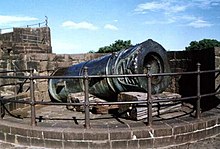Malik-E-Maidan
Malik-E-Maidan | |
 A view of the Malik-E-Maidan Cannon, placed at Bijapur Fort. | |
 | |
| Location | Bijapur, India |
|---|---|
| Designer | Muhammad Bin Husain Rumi |
| Type | Cannon |
| Material | Bell metal |
| Length | 4.45 metres (14.6 ft) |
| Completion date | 1549 |

The Malik-E-Maidan also Malik-i-Maidan (lit. 'Lord of the Battlefield'), is a 16th century cannon, located at Burj-E-Sherz (Lion Tower), Bijapur Fort, Bijapur, India. 4.45 metres (14.6 ft) in length and cast in bell metal, it is the largest surviving block of artillery from the Medieval period.
History
[edit]The cannon was cast in 1549 by the Persian engineer Muhammad Bin Husain Rumi, then serving Sultan Burhan Nizam Shah I of Ahmednagar.[1] The Sultan presented the cannon to his son-in-law, Sultan Ali Adil Shah I of Bijapur.[2][3][4]
In 1565, the cannon was used in the Battle of Talikota by the Bijapur Sultan Ali Adil Shah I, attacking Aliya Rama Raya of the Vijayanagara Empire as part of the combined Deccan Sultanates force. After the victory of the Deccan Sultanates the cannon was named Malik-i-Maidan.[3][4] At some point in the next 59 years, control of the cannon was transferred from the Bijapur Sultanate to the Ahmadnagar Sultanate.[citation needed]
In 1625, Prime Minister Malik Amber of the Ahmadnagar Sultanate transported the Malik–i-Maidan with the help of trained war elephants from Daulatabad Fort south to Sholapur, as part of his invasion of the Bijapur Sultanate. He would later transport the cannon north again, as he retreated after unsuccessfully besieging of the city of Bijapur, and subsequently used it in the Battle of Bhatvadi against the Mughals and Bijapur Sultanate.[5]
The cannon, among the world's largest in its category, was attempted to be moved to Great Britain by the East India Company as a war trophy, but due to its huge size and un-conditioned transport infrastructure the cannon could not be transported.[6]
Structure
[edit]The Malik-e-Maidan is made of bell metal, measuring 4.45 metres (14.6 ft) in length,[7] The muzzle gauge is 700 millimetres (28 in) and 1.5 metres (4 ft 11 in) in overall diameter, weighing 55 tons.[8] According to legend, the cannonball could travel up to 500 metres (1,600 ft).[9]
Decoration
[edit]The cannon's muzzle is decorated with a low relief of the head of a lion with its jaws open, swallowing an elephant.[3]
Inscriptions
[edit]Three inscriptions can be found on the cannon, of which two were inscribed during Burhan Nizam Shah I of Ahmednagar as per the inscriptions. It was cast at Ahmadnagar from bell metal by Muhammad Bin Husain Rumi in 1549. The third inscription was added by Aurangzeb when he conquered Bijapur in 1685–86.[3]
See also
[edit]References
[edit]- ^ Navina Najat Haidar; Marika Sardar (2015). Sultans of Deccan India, 1500–1700. Metropolitan Museum of Art. p. 18. ISBN 9780300211108. Retrieved 8 August 2022.
- ^ "Vijayapura Place of interest". Government of Karnataka. 17 February 2021. Retrieved 24 February 2021.
- ^ a b c d "View of the Malik-i-Maidan Gun in the Fort at Bijapur". British Library. 26 March 2009. Retrieved 24 February 2021.
- ^ a b Wagoner, Philip B; Eaton, Richard M (2014). "Warfare on the deccan plateau, 1450-1600 : A Military Revolution in early modern India?". Journal of World History. 25 (1): 5–50. doi:10.1353/jwh.2014.0004. S2CID 162260578.
- ^ Sadiq Ali, Shanti (1996). The African Dispersal in the Deccan: From Medieval to Modern Times. Orient Blackswan. pp. 81 and 86. ISBN 9788125004851. Retrieved 24 February 2021.
- ^ The Fortnightly. Vol. 34. Chapman & Hall. 1880. p. 226. Retrieved 24 February 2021.
- ^ Limca Book of Records. Hachette. 2018. ISBN 9789351952404. Retrieved 3 August 2023.
- ^ Forty, Simon; Marriott, Leo (2017). Heavy weights; The Military Use of Massive Weapons. Book Sales. p. 51. ISBN 9780785835493. Retrieved 3 August 2023.
- ^ The Land of the Rupee. Bennett, Coleman and Company Limited and The University of Michigan. 1912. p. 283. Retrieved 3 August 2023.
